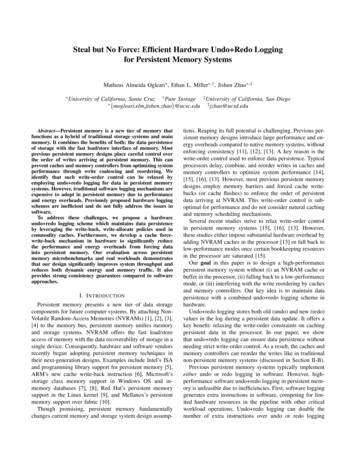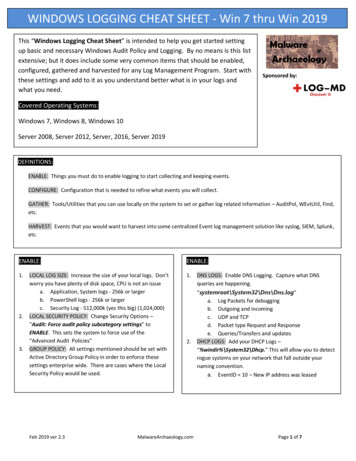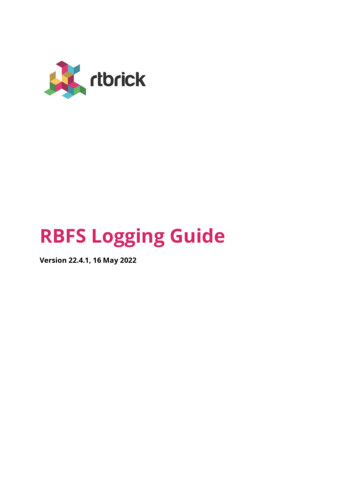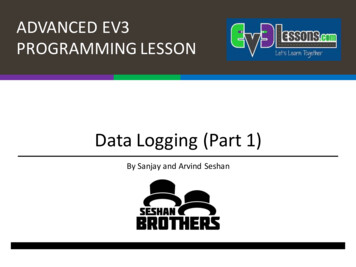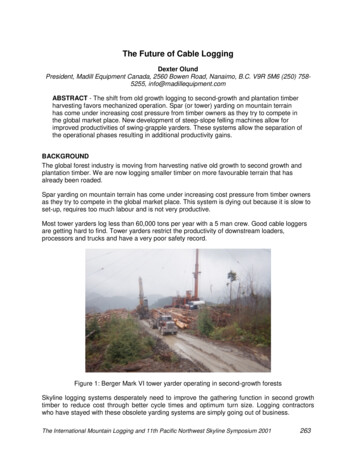
Transcription
The Future of Cable LoggingDexter OlundPresident, Madill Equipment Canada, 2560 Bowen Road, Nanaimo, B.C. V9R 5M6 (250) 7585255, info@madillequipment.comABSTRACT - The shift from old growth logging to second-growth and plantation timberharvesting favors mechanized operation. Spar (or tower) yarding on mountain terrainhas come under increasing cost pressure from timber owners as they try to compete inthe global market place. New development of steep-slope felling machines allow forimproved productivities of swing-grapple yarders. These systems allow the separation ofthe operational phases resulting in additional productivity gains.BACKGROUNDThe global forest industry is moving from harvesting native old growth to second growth andplantation timber. We are now logging smaller timber on more favourable terrain that hasalready been roaded.Spar yarding on mountain terrain has come under increasing cost pressure from timber ownersas they try to compete in the global market place. This system is dying out because it is slow toset-up, requires too much labour and is not very productive.Most tower yarders log less than 60,000 tons per year with a 5 man crew. Good cable loggersare getting hard to find. Tower yarders restrict the productivity of downstream loaders,processors and trucks and have a very poor safety record.Figure 1: Berger Mark VI tower yarder operating in second-growth forestsSkyline logging systems desperately need to improve the gathering function in second growthtimber to reduce cost through better cycle times and optimum turn size. Logging contractorswho have stayed with these obsolete yarding systems are simply going out of business.The International Mountain Logging and 11th Pacific Northwest Skyline Symposium 2001263
Preset chokers, electric chokers and motorized drop line carriages have improved cycle timesand the gathering function on skyline towers. Timber owners find skyline methods extremelyexpensive due to high labour content and relatively low productivity, hence they will only useskylines where they are forced to by environmental legislation. Remote pockets of quality oldgrowth timber are now often logged by helicopter at higher cost in order to eliminateenvironmentally unpopular new road development.MECHANIZED HARVESTING - FELLER BUNCHER AND SHOVEL YARDINGShovel logging provides a low cost alternative on downhill slopes to 40% and distances to 800ft. from the road. Shovel logger productivity can run to 100,000 tons per year in coastal timberwith a single operator in a safely guarded cab.Figure 2: A 3800C log loader that can be used for shovel yardingNow that most of the harvesting is in second growth, steep terrain felling machines are theoptimum way to gather and orient turns on slopes to 60%. The latest sawhead shown here is a360º Quadco 28” intermittent swing saw. It can cut literally any size tree, directionally fell it andonce the cutting disc is retracted it acts like a grapple to make bunches and orient the tree withbutt to the road for yarding. The productivity of this unit is around 650 tons in an 8 hour shift andmost companies operate double shift, so one machine can cut about 250,000 tons annually.Figure 3: The Madill 2200 Feller-BuncherThe International Mountain Logging and 11th Pacific Northwest Skyline Symposium 2001264
Mechanized Cable Yarding Operations – Feller Bucher and Swing Grapple YardersFeller bunching is particularly advantageous where swing grapple Yarders can be employedand raises yarder productivity into the 100 ton per hour range with a two man yarding crew atdistances up to 1200 ft. Not only is labour cost cut by 2/3, there are also huge benefits in fallerand yarding crew safety. The Madill 124 swing yarder shown here logs 160,000 tons per year.The day I took this photo it yarded 1,100 tons.The secondary advantage of swing grapple Yarders is their ability to pile at roadside and moveaway thereby eliminating the congestion and unsafe working environment of a landing.Figure 4: The Madill 124 Swing Yarder in grapple configurationIf the four phases of harvesting ie: falling, yarding, processing and loading can be divorced by atime span of even one week, each machine is no longer limited by the mismatch in productionrate of the others.To maintain productive cycles, mobility at the back end of a cable operation is equally important.The trend here is to use 30 tonne excavators with raised swivelling fairleads In many plantationforests old growth stumps are no longer available so loggers must either dig dead man anchors,use bulldozers or old feller bunchers for iron stumps. Iron stumps are quick to move and havethe advantage that they will never suddenly let go or break a guyline. They make quick roadchanges and provide that sorely needed lift at the back end. With a mobile tailhold and mobileguyline anchor the whole side can bring in the lines, move, set-up and be logging in anotherblock in 1 hour.Maximum productivity from each machine becomes a major issue where stand density is lowand trees are small. In low density stands a mobile yarding side will log 8 to 10 acres a day. Bydivorcing the phases, each machine can work at 100% of its capacity every day without waitingto be fed by the previous phase or encountering delays due to landing or road congestion.There is no longer a need to build costly landings that add to site degradation. Divorcing thephases takes all the panic out of breakdowns since the other phases keep on producing.Repairs can now be done properly and in the most economic fashion.The International Mountain Logging and 11th Pacific Northwest Skyline Symposium 2001265
Figure 5: Excavator used as mobile tailholdWhere oversize timber and steep pitches dictate felling by hand, shovel loggers can be used tomake optimum yarder turns. A swing grapple yarder cycles every 60 seconds and is usuallyfaster than the shovel. Shovel logging in a yarder setting can help to pull away from sensitiveriparian zones or to clean off areas where cable deflection is poor. Shovel logging to a yarderreally helps to maintain high production every shift. In some cases shovel loggers are doing hothand offs to grapple yarders. Looking closely you can see that the yarding grapple is on and theshovel logger hasn’t let go yet.Many crews will grapple the front of the setting and quickly switch to a mechanical slack pullingcarriage farther out on each tail block. This requires a 3 man yarding crew.ROADSIDE PROCESSINGWindrow storage naturally leads to mechanical processing at roadside. Mechanical processorshave a production rate of 50 tons per hour and usually operate double shift to keep up to agrapple yarder in bunched woodTotal mechanical harvesting with divorced phases and no people on the ground leads right intodouble shifting, with a crew rotation of four-ten hour days on, four days off , and ultimately a 20hr/day, seven days a week operation to maximize equipment utilization. We now havecontractors who clock 5500 hrs/year on their equipment. No people on the ground translatesinto a perfect safety record.An inventory of processed logs at roadside lends themselves to high production loading. Bigbutt and top loaders easily load 160 tons per hour and virtually eliminate truck waiting time.Daily production usually runs about 1200 tons.THE REDESIGNED 255B SLR SWINGERFor loggers who want the easy move and rig up of a swinger but may still need to skyline, Madillhas redesigned the Thunderbird 255B SLR. The Madill 255B is versatile for running skylineinterlock, shotgun, high head, or slack skyline modes. It has a 450 HP cat 3406E engine with atwin disc 5 speed powershift transmission. The 255B can put up 2000 ft. of 1 1/8 swaged skylineand operate with a motorized drop line carriage if desired.The International Mountain Logging and 11th Pacific Northwest Skyline Symposium 2001266
Figure 6: A redesigning the TB 255B SLR results in a versatile yarder. Shownhere is an example of a TSY 255The future is already here. Whether we like it or not cable logging is moving to around the clockmechanized high production systems in plantation forests.The International Mountain Logging and 11th Pacific Northwest Skyline Symposium 2001267
The International Mountain Logging and 11th Pacific Northwest Skyline Symposium 2001 263 The Future of Cable Logging Dexter Olund President, Madill Equipment Canada, 2560 Bowen Road, Nanaimo, B.C. V9R 5M6 (250) 758-5255, info@madillequipment.com ABSTRACT - The shift from old growth logging to second-growth and plantation timber





